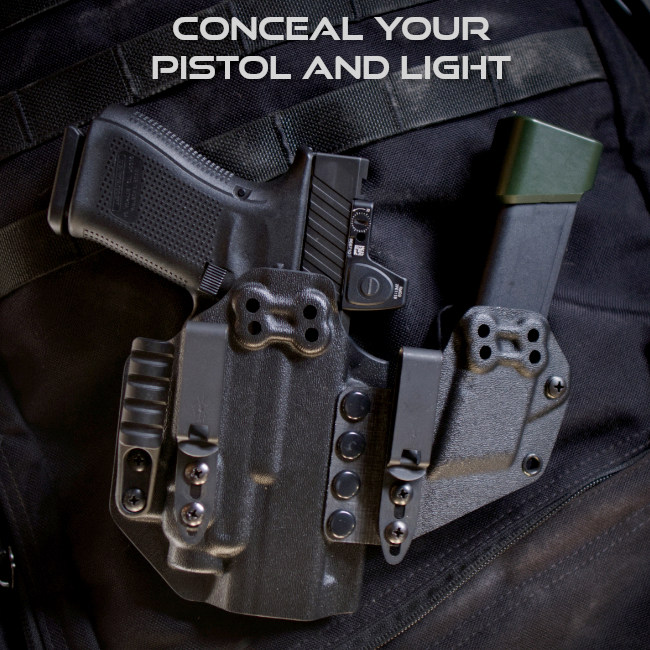Introduction
Cloud has a history of very high lumen and candela claims. The new MCH-HC3 is no exception, boasting 100,000 candela and 1,250 lumens. Can it meet these specs?
Let’s find out.
First Impressions
The MCH-HC3, like other cloud lights, looks nice.
It ships with a pocket clip that’s fairly stout and won’t tear up your jeans.

Cloud has had some QC issues in the past – in particular, the lights would flicker during use. At SHOT Show, Cloud told us that this issue only affects a small percentage of their customers. My personal experience, though, is that nearly every MCH I’ve bought ends up flickering at some point. Regardless, Cloud claims to have made design changes in their newer lights that fix this issue.
The MCH-HC3 is larger in diameter than previous Cloud handhelds, but it’s still manageable for EDC. Here’s a side-by-side with a Modlite:

Let’s get into the specs.
Manufacturer Claims and Specs
| Spec | Cloud Defensive MCH-HC3 |
| Lumens | 1,250 |
| Candela | 100,000 |
| Runtime | 65+ Min Run-time (Full Power) 6+ Hours (Low) |
| Length | 5.17″ |
| Diameter | 1.3″ |
| Ingress Protection | IPX-8 (100 feet, 24 hours) |
| Price | $218.99 (as of 4.7.25) |
As usual, this light takes an 18650. It ships with a Samsung 30Q.

If the claims are true, this should be a spectacular EDC light.
Let’s see how it does.
Into the Lab: Lumens, Candela, Runtime, Color Temp and CRI
Lumens
The Cloud Defensive MCH-HC3 should produce 1,250 lumens. We bought two samples for testing.
Let’s get a closer look at the first ten minutes:
From these charts, it looks like the Cloud is using active thermal regulation in order to maximize its output over time. This is a fairly advanced feature, but unfortunately, it’s poorly tuned.
If you want to see an example of good thermal regulation, see this review on the Noctigon KR1.
The Cloud lights (especially sample one) oscillate significantly over the course of their runtime. If I were working on my car, and the output of my flashlight was going from ~600 to ~225 lumens every minute, it could get frustrating.
Both lights tapered from ~20 lumens to ~10 lumens from ~1:45:00 to ~3:00:00.
Regardless, as a defensive handheld, the MCH-HC3 shows great promise.
By the ANSI/Plato sampling standard (which technically requires three samples, here we only have two) this light produces 1,183 lumens, or ~95% of its claimed output. Sample one ran for 1:20:37, and sample two ran for 1:26:37. They both exceeded the “65+ Minute” runtime spec.
Candela
The Cloud Defensive MCH-HC3 should produce 100,000 candela.
| Candela (0s) | Candela (30s) | |
| Sample One | 89470 | 80880 |
| Sample Two | 93680 | 88010 |
I’m impressed. Not quite 100,000, but still good.
By the ANSI/Plato sampling standard (which technically requires three samples, here we only have two) this light produces 84,445 candela, or ~84% of its claimed candela output.
It’s certainly enough to punch across some acreage or blind someone close up.
Color Temp and CRI
While many tactical lights focus on sheer output over light quality, Cloud has in the past attempted to improve their color temp with special coatings on the lens. Let’s see how the MCH-HC3 performs.

The MCH-HC3 has a color temp of ~6000K, which is cool, but not terrible. Its CRI is 68.7, meaning the MCH-HC3 will not portray colors very accurately. As a defensive light, though, this isn’t much of a problem.
Conclusion
The MCH-HC3 surprised me. As a defensive light, it’s great, since it’s totally blinding for the first two minutes (which is hopefully all the time you need).
As an EDC, its unstable output might be irritating, especially when there are alternatives from the competition (like the SureFire EDC2-DFT) that don’t have this issue.
I’ve not done any long-term testing on this light, so I can’t vouch for its reliability. But Cloud is good about their warranty.
Here’s a quick pro/con list for those on the fence:
| Pro | Con |
| High candela High lumen output Fairly Priced Made in USA | New (Unproven) Design Fluctuating Output |







